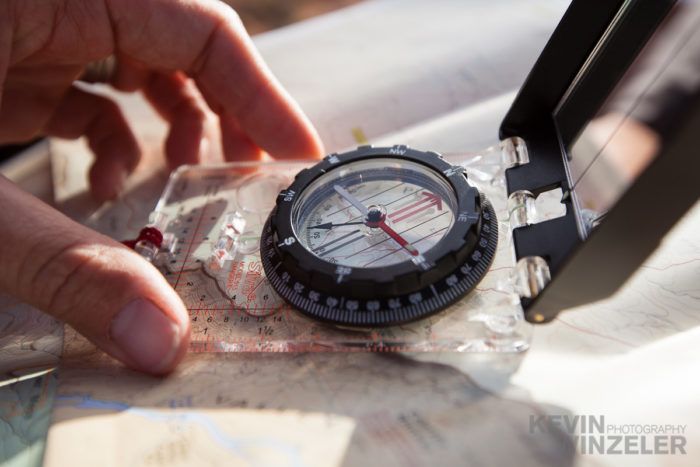Compass Parts: Know Your Instrument
Before you can hike around in the most confusing patch of forest and still find your way home, before you can spot a far-off peak and trek directly to it–heck, before you can even call yourself a beginner and use that new compass to start some basic orienteering, you need to know exactly what that bit of plastic and magnetic magic you have in your hand is.

Just about everybody older than a Cub Scout knows roughly how a compass works: A spinning needle aligns itself with the Earth's natural magnetic field to always point the way north. But knowing what a compass does and being able to use it are two different things.
The first metaphoric step toward taking that first literal step into the wild is identifying the parts of your compass. In general, a exploration-friendly compass is going to have:
A BASEPLATE
This flat, roughly rectangular surface holds the compass housing and is marked with lines, numbers, and other information necessary to translating data from maps into information that can be used in the real world (as in: If we want to get to the river, we have to go that way). Transparent baseplates allow users to see the map beneath. Higher-end compasses will have an ergonomic design so they fit comfortably into users? hands.
SCALES AND RULERS
These are the lines and numbers that run along the edges of the baseplate, revealing distances on paper and conversions into actual distances (as in: This many inches is actually this many miles). Hikers use these by setting the straight edge of the baseplate on the map to mark the distance from one point to another, calculated along a straight line. Note that many maps are drawn to a particular scale, so you should check a compass's baseplate edge to see if it bears the markings that correspond to the scale in question.
DIRECTION OF TRAVEL ARROW
This is usually a small triangle that points to the shortest edge of the baseplate away from the compass housing. When holding the compass flat in front of you, the arrow will point forward and away from you. When navigating, hikers use this arrow to point the way they're going (which obviously isn't always north).
MAGNIFIER
A small, circular magnifier allows users to take a closer look at tiny details on a map. The direction of travel arrow may be connected to the magnifier, like a tiny party hat on top of a very round head.
INDEX LINE
This is the end of the straight line from the direction of travel arrow where it touches the dial. It may sit on the opposite end of the magnifier.
DIAL
This circle rotates around the housing. It's marked in degrees, going from 0 to 360 for a complete circle.
DECLINATION SCALE
These marks help users if they're navigating in an area in which magnetic north and true north don't exactly match up. 'Declination' is the term for the difference between the two, which can change depending on the user's spot on the globe. Declination can also change over time, shifting from year to year.
ORIENTING ARROW
This is an arrow marked on the base of the housing, and it rotates along with the dial. When orienteering, it can be lined up with the magnetic needle and kept there to ensure that a hiker is properly following the bearing (don't worry if you don't understand all of the terms here more posts about orienteering basics are on the way).
ORIENTING LINES
These lines run parallel to and rotate with the orienting arrow. They aid in navigation, especially when the compass is sitting on a map.
NEEDLE
This is the thin, magnetized sliver that spins in relation to the Earth's magnetic field and indicates the direction of north. It's the key component of a compass. (To better understand how it works, consider making your own basic compass as an exercise.)
HOUSING
The needle spins inside of this, which is enclosed and raised above the rest of the baseplate. The dial rotates around it. All compasses are different. Some come with everything mentioned here, some have mirrors and other features for more advanced techniques, and some are stripped-down tools perfect for learning the basics. The jargon involved with a compass may seem confusing at first, but trust us: You'll pick it up quickly, especially if you practice in the wild–with an experienced friend to help out, just in case.
(Thanks to Compass Dude and Wilderness Camping for inspiration for this post.)